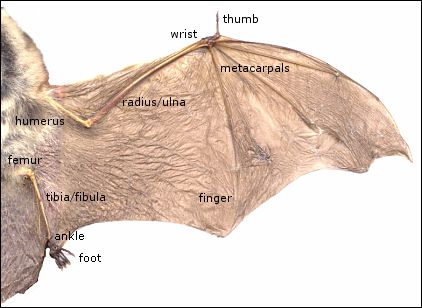

One of the more amazing natural features of animals is the manipulation through evolution of a basic plan of some body structure to accomplish many a task. The classic example is the forelimb of land vertebrates. Whether you're looking at the forelimb of a Roadrunner, a Pallid Bat, a Bighorn Sheep, or your favorite human, it's like looking into the fun mirrors at a carnival.
In the bat, the hand is enlarged to form the main part of the wing,
while in the bird, fingers are lost and bones fused to support the wing feathers. The
Bighorn's upper arm has contracted, its lower limb elongated, and two fingers bear
its weight. Your favorite person's front limb actually is the most primitive of all
of these. We've lost almost nothing, we've fused together nothing, our
limb's not all that different from those of mammals over 65 million years
ago—except in one important feature. We can touch our thumb to each of our other
fingers—the opposable thumb that lets us be Man, the Tool Maker.

Contributor: Arthur H. Harris, Laboratory for Environmental Biology, Centennial Museum, University of Texas at El Paso.
Desert Diary is a joint production of the Centennial Museum and KTEP National Public Radio at the University of Texas at El Paso.

Left side of a mouse-eared bat, Myotis auriculus, from the under side. The
wing is made up of the same basic elements as our own forelimbs, with differences
largely due to changes in proportions and, of course, the spreading out of the skin to
form the flight membrane. The hind leg, likewise, is basically similar to that of other
mammals. Scanned LEB specimen. </> ![]()
Strickberger, M. W. 2000. Evolution. 3rd ed., Jones and Bartlett
Publishers, Sudbury, MA. ![]()